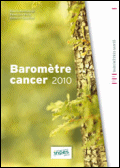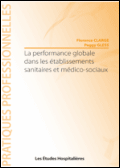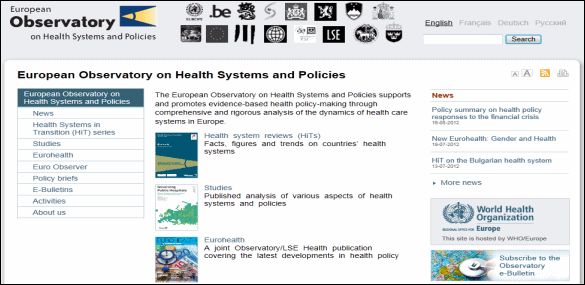LU POUR VOUS DE SEPTEMBRE 2012 :
 livres du mois
livres du mois
 sites du mois
sites du mois
 working papers
working papers
Tous les lu pour vous
LES LIVRES DU MOIS
Les assurances maladie.
Bras P.L., Tabuteau D.
Paris : Presses Universitaires de France : 2012 : 128 p.
Comprendre le système de santé français passe nécessaire aujourd'hui par la connaissance des missions respectives de l'assurance maladie obligatoire et des assurances complémentaires – privées, mutualistes et paritaires – et de la manière dont elles s'articulent. L'une des raisons en est l'augmentation constante des sommes laissées à la charge des ménages, qui se traduit par des difficultés croissantes d'accès aux soins mais aussi par l'essor des assurances maladie complémentaires. L'autre raison est l'enjeu majeur que constitue désormais la régulation des dépenses de santé. Cet ouvrage propose le premier panorama des assurances maladie en France. Il met en lumière les caractéristiques divergentes et convergentes de ces deux piliers de la protection sociale contre la maladie et éclaire ainsi les politiques de santé menées actuellement (4e de couv).
Politiques sociales et de santé : comprendre et agir.
Andre-Pechaud A., Clave S., Huteau G., Ponchon F., Rayssiguier Y. / dir., Jegu J. / dir., Laforcade M.
Rennes : Presses de l'EHESP : 2012 : 672 p.
Les questions sanitaires et sociales passionnent autant la population que le législateur. Dans ce secteur, plus que dans tout autre, l'explosion normative et réglementaire a créé un enchevêtrement de politiques et d'acteurs d'une rare complexité. L'ambition des auteurs est de présenter l'ensemble des politiques de manière thématique, sous une forme raisonnée, sans exclure analyses et commentaires critiques. L'action sanitaire et sociale ne peut se résumer à la présentation du droit positif et des politiques publiques. Pour être comprise, elle suppose des références à la science politique, à la sociologie des acteurs, aux théories de la complexité ou à l'analyse systémique. Ces références contribuent au regard critique qui est aussi celui des auteurs. Sont ainsi abordés en détail le contenu précis des politiques, leur genèse, leur environnement, le jeu des acteurs qui les animent, les valeurs qui les portent, les méthodes et outils auxquels elles ont recours. Dès la première édition de cet ouvrage, les auteurs ont choisi de traiter conjointement des politiques sanitaires et sociales. Les séparer peut donner l'illusion de la simplification. Mais cette disjonction ne résiste pas à l'analyse, tant les besoins de la population et le contenu des politiques relient de plus en plus étroitement les dimensions sanitaire et sociale. Les récentes évolutions n'ont fait que conforter ce parti pris (4e de couverture).
Baromètre Cancer 2010.
Beck F. / dir., Gauthier A. / dir.
Saint-Denis : INPES, Boulogne Billancourt : INCA : 2012/06 : 268 p.
Le cancer est devenu, au cours des années 2000, la première cause de décès en France. On estime aujourd'hui que 1 200 000 personnes vivent avec un cancer ou après avoir eu un cancer. Ces données montrent l'importance des enjeux sociaux et de santé publique liés à cette pathologie. Le Baromètre cancer 2010 est la deuxième vague, après le Baromètre cancer 2005, d'une enquête menée en population générale. Lancée dans le cadre d'une collaboration entre l'Institut national du cancer et l'Institut national de prévention et d'éducation pour la santé, cette étude vise à identifier les évolutions des perceptions, des risques et des comportements entre les deux enquêtes. Un échantillon représentatif de 4 000 personnes de 15 à 85 ans a été interrogé sur ses connaissances, attitudes et comportements concernant les facteurs de risque du cancer, mais également sur ses représentations de la maladie et l'image des malades. Les personnes ont également été questionnées sur la qualité perçue des soins ainsi que sur les pratiques de dépistage mises en oeuvre par les pouvoirs publics. Cet ouvrage permet ainsi de mesurer les évolutions et les progrès réalisés depuis 2005, mais aussi les avancées qui restent à faire, en particulier dans le domaine des inégalités sociales de santé. Leur réduction est un élément pivot du Plan cancer 2009-2013 (Résumé d'auteur).
La territorialisation des politiques de santé : actes.
Castaing C. / dir
Bordeaux : Les Etudes Hospitalières : 2012 : 197 p.
La territorialisation des politiques de santé est une approche d'une politique publique qui détermine un territoire pour l'analyse des besoins de santé et de l'offre sanitaire et un lieu de pouvoir doté d'une certaine autonomie. Le projet de recherche sur ce thème s'inscrit dans un projet plus large lancé en 2010 portant sur la territorialisation des politiques publiques en Europe, qui lui-même s'inscrit dans la thématique prioritaire régionale « Europe des régions, Europe des réseaux ». Soutenu par le conseil régional d'Aquitaine et présenté par la Maison des Sciences de l'Homme d'Aquitaine, ce travail collectif est porté par le Centre d'étude et de recherche sur le droit administratif et la réforme de l'État (CERDARE) de l'université Montesquieu-Bordeaux IV et associe plusieurs centres de recherche bordelais qui ont vocation à travailler ensemble dans une perspective transnationale et comparatiste. Il s'agit de réfléchir sur les transformations de l'action publique en Europe, et la territorialisation des politiques de santé est une des approches sectorielles déclinées dans ce projet. Relativement récente, cette manière de concevoir la politique de santé a déjà fait l'objet de nombreuses études, et le premier défi de la réflexion est de s'inscrire dans une démarche originale, comparatiste : l'analyse porte sur les transformations juridiques des cadres territoriaux de l'action sanitaire en France, mais aussi dans d'autres États membres de l'Union européenne (Angleterre et Espagne). La journée d'étude a donné l'occasion à des universitaires et des acteurs de santé d'alimenter la réflexion doctrinale sur la territorialisation et le territoire pertinent à la lumière des spécificités des contextes politiques et administratifs, nationaux et locaux dans lesquels s'inscrit ce mouvement (4e de couverture).
La performance globale dans les établissements sanitaires et médico-sociaux.
Clarge F., Gless P.
Bordeaux : Editions Hospitalières : 2012 : 124 p.
L'ouvrage démontre que la performance globale intégrée dans le management des établissements sanitaires et médico-sociaux est essentielle pour une gouvernance collective et responsable, facteur d'efficience pour tous. Il donne tous les outils pour mettre en oeuvre de manière pratique la performance globale dans son établissement. La première partie définit le concept de performance globale mais également les enjeux pour un établissement dans sa mise en oeuvre, comme un véritable outil de management. La seconde partie analyse l'existant dans le secteur de la santé et montre que, si la performance globale est encore peu présente dans le secteur de la santé, elle est centrale dans tous les textes et les évolutions actuelles visant la performance. La troisième partie de cet ouvrage propose un outil d'auto-diagnostic et définit de manière très concrète les actions à mettre en place dans un établissement pour atteindre un management responsable et performant (4e de couverture).
An introduction to health planning for developing health systems.
Une introduction à la planification sanitaire dans les systèmes de santé en voie de développement.
Green A.
Oxford : Oxford University Press : 2007 : 397 p.
This text, the latest edition, explains the importance of health planning in both developing regions such as Africa, and those in transition, such as Central and Eastern Europe. It stresses the importance of understanding the national and international context in which planning occurs, and provides an up to date analysis of the major current policy issues, including health reforms. Separate chapters are dedicated to the distinct issues of finance for health care and human resource planning. The book explains the various techniques used at each stage of the planning process, looking first at the situational analysis and then looking in turn at priority-setting, option appraisal, programming, implementation, monitoring, and evaluation. The book ends by examining the challenges facing planners in the 21st century, particularly in the light of growing globalization. A major theme of the book is the need to recognise and reconcile the inevitable tension that lies between value judgements and ‘rational' decision-making. As such, in addition to introducing techniques such as costing and economic appraisal, it also outlines techniques such as stakeholder analysis for understanding the relative attitudes and power of different groups in planning decisions. Each chapter includes a comprehensive bibliography (including key websites), a summary, and exercises to help with practise of techniques and understanding the content. The book argues that all health professionals and community groups should be involved in the planning process for it to be effective (4e de couverture).
LES SITES DU MOIS DE SEPTEMBRE
King's fund
www.kingsfund.org.uk
Presentation
Association à but non lucratif qui cherche à comprendre comment le système de santé en Angleterre peut être amélioré. Il a pour ambition d'aider à façonner la politique, de transformer les services et de susciter des changements de comportement. Ses travaux comprennent la recherche, l'analyse, le développement d'un leadership et l'amélioration des services. Il offre également un large éventail de ressources pour aider tous ceux qui travaillent dans la santé, dans un souci de partage des connaissances. Il organise des conférences et autres événements. Son site permet d'accéder à leurs bases de données bibliographiques couvrant ses thèmes de prédilection : politique de santé britannique, inégalités de santé, soins de santé intégrés, santé mentale, soins primaires etc… Il propose également des bibliographies thématiques et une lettre d'actualité.
OCDE-Espace santé
www.oecd.org/fr/sante
Presentation
L'espace santé du site de l'OCDE regroupe toutes les informations sur les politiques et données sur la santé ainsi que sur les biotechnologies. On y retrouve les publications relatives à ce thème (rapports, documents de travail, panorama annuel sur la santé). Il constitue également un point d'entrée vers la base de données de l'OCDE sur la santé, avec une sélection des principaux indicateurs en format Excel et des notes synthétiques pour 40 pays à partir des données les plus récentes publiées dans la base. Enfin, il présente les derniers projets analytiques sur la santé en cours au sein de l'OCDE.
OMS-European Observatory on Health Systems and Policy
www.euro.who.int/en/who-we-are/partners/observatory
Presentation
L'Observatoire européen sur les systèmes et politique de santé soutient et promeut des politiques de santé fondées sur des preuves grâce à une analyse complète et rigoureuse de la dynamique des systèmes de santé en Europe. Il produit de nombreuses publications de référence sur le système de santé européen.
- Health Systems in Transition (HiT) series : série de monographies nationales qui fournit une description détaillée des systèmes de santé des pays appartenant à la zone Europe de l'OMS ainsi que certains autres pays de l'OCDE.
- European Observatory on Health Systems and Policy : Les volumes de cette série portent sur des questions clés pour l'élaboration des politiques de santé en Europe. Un résumé des questions abordées dans ces publications font généralement l'objet d'un "Policy Brief"
- Eurohealth : publication trimestrielle qui offre une tribune pour les chercheurs, les décideurs et les experts à exprimer leurs vues sur les questions de politique de santé et de contribuer ainsi à un débat constructif sur les politiques de santé en Europe. En 2011, cette publication a intégré la publication "Eurobserver".
Il est possible de s'abonner à une newsletter.
Observatoire National de la Pauvreté et de l'Exclusion Sociale
www.onpes.gouv.fr
Presentation
Créé en 1998, cet observatoire a pour mission de rassembler les données relatives aux situations de pauvreté, de faire réaliser des travaux d'étude, de recherche et d'évaluation, de diffuser annuellement les informations recueillies, et de contribuer ainsi au développement de la connaissance dans ce domaine. Ce site présente l'observatoire et ses publications ainsi que les rapports officiels extérieurs.
VU DE L'ETRANGER : QUELQUES WORKING PAPERS ANALYSES
Assurance maladie
Health insurance as a productive factor. 

Dizioli A., Pinheiro R.B. (2012)
Munich : Munich Personal RepEc Archive
This paper presents a less-explored channel through which health insurance impacts productivity: by offering health insurance, employers reduce the expected time workers spend out of work in sick days. Using data from the Medical Expenditure Panel Survey (MEPS), it shows that a worker with health coverage misses on average 52% fewer workdays than uninsured workers, after controlling for endogeneity. It develops a model that embodies this impact of health coverage in productivity. In its model, health insurance reduces the probability that a healthy worker gets sick, missing workdays, and it increases the probability that a sick worker recovers and returns to work. In its model, firms that offer health insurance are larger and pay higher wages in equilibrium, a pattern observed in the data. It calibrated the model using US data for 2004 and show the impact of increases in health costs, as well as of changes in tax benefits of health insurance expenses, on labor force health coverage and productivity. Finally, it shows that a government mandate that forces firms to offer health insurance increases average wages and aggregate productivity while reducing aggregate profits, ultimately having a positive impact on welfare.
Hôpital
English hospitals can improve their use of resources: an analysis of costs and length of stay for ten treatments. 

Gaughan J., Mason A., Street A., Ward P. (2012)
York : University of York
This study investigates variations in costs and length of stay (LoS) among hospitals for ten clinical treatments to assess: 1. The extent to which resource use is driven by the characteristics of patients and of the type and quality of care they receive; 2. After taking these characteristics into account, the extent to which resource use is related to the hospital in which treatment takes place ; 3. If conclusions are robust to whether resource use is described by costs or by LoS. Data analysed came from patient-level data from the Hospital Episode Statistics (HES) data for 2007/8, which contains approximately 16.5 million inpatient records. This dataset was merged with costs derived from the Reference Cost database. Data were extracted on three medical ‘conditions' (acute myocardial infarction (AMI); childbirth; stroke) and seven surgical treatments (appendectomy; breast cancer (mastectomy); coronary artery bypass graft (CABG); cholecystectomy; inguinal hernia; hip replacement; and knee replacement).For each treatment, the study used a two-stage approach to investigate variations in cost and LoS. In stage I, it ran fixed effects models to explore which patient-level factors explain variations. In stage II, it regressed the fixed effects from stage I against an array of hospital characteristics.
The Relationship between Quality and Hospital Case Volume. An Empirical Examination with German Data. 

Hentschker C., Mennicken R. (2012)
Bochum : Ruhr-Universität Bochum
This paper examines the effects of hospital case volume on quality of care on the example of intact abdominal aortic aneurysm (AAA) and hip fracture (HIP). We conduct the analysis on patient level with multiple logistic regression analysis. Quality is measured with a binary variable which indicates whether the patient has died in hospital. The results show that patients who are treated in hospitals with a higher case volume have on average a significantly lower probability of death.
Does Seeing the Doctor More Often Keep You Out of the Hospital? 

Kaestner R., Lo S.A. (2012)
Cambridge : NBER
By exploiting a unique health insurance benefit design, this paper provides novel evidence on the causal association between outpatient and inpatient care. The results indicate that greater outpatient spending was associated with more hospital admissions: a $100 increase in outpatient spending was associated with a 2.7% increase in the probability of having an inpatient event and a 4.6% increase in inpatient spending among enrollees in our sample. Moreover, it present evidence that the increase in hospital admissions associated with greater outpatient spending was for conditions in which it is plausible to argue that the physician and patient could exercise discretion.
Médicaments
Pharmaceutical innovation and longevity growth in 30 developing and high-income countries, 2000-2009. 

Lichtenberg F.R. (2012)
Cambridge : NBER
This paper examines the impact of pharmaceutical innovation, as measured by the vintage of prescription drugs used, on longevity, using longitudinal- , country-level data on 30 developing and high-income countries during the period 2000-2009. It controls for fixed country and year effects, real per capita income, the unemployment rate, mean years of schooling, the urbanization rate, real per capita health expenditure (public and private), the DPT immunization rate, HIV prevalence and tuberculosis incidence. Life expectancy at all ages and survival rates above age 25 increased faster in countries with larger increases in drug vintage. The increase in drug vintage was the only variable that was significantly related to all of these measures of longevity growth. Controlling for all of the other potential determinants of longevity did not reduce the vintage coefficient by more than 20%. Pharmaceutical innovation is estimated to have accounted for almost three-fourths of the 1.74-year increase in life expectancy at birth in the 30 countries in our sample between 2000 and 2009, and for about one third of the 9.1-year difference in life expectancy at birth in 2009 between the top 5 countries (ranked by drug vintage in 2009) and the bottom 5 countries (ranked by the same criterion).
Launching prices for new pharmaceuticals in heavily regulated and subsidized markets. 

Puig-Junoy J., Gonzalez L.O.P.E. (2012)
Barcelone : Universita Pompeu Fabra
This paper provides empirical evidence on the explanatory factors affecting introductory prices of new pharmaceuticals in a heavily regulated and highly subsidized market. The authors collect a data set consisting of all new chemical entities launched in Spain between 1997 and 2005, and model launching prices. They found that, unlike in the US and Sweden, therapeutically "innovative" products are not overpriced relative to "imitative" ones. Price setting is mainly used as a mechanism to adjust for inflation independently of the degree of innovation. The drugs that enter through the centralized EMA approval procedure are overpriced, which may be a consequence of market globalization and international price setting.
Soins de santé primaires
The Effect of Physician Supply on the Mix of Generalist and Specialist Services Used. 

Mc Leod L. (2011)
Hamilton : McMaster University
Variations in physician supply and how this impacts a patient's access and use of physician services remains a concern for many health care systems. This paper asks how the supply of physicians affects both the number of visits and the dollar value of services received from GPs and specialists? Results indicate the supply effect shows a 10% increase in GP supply is associated with an increase in GP use (from 0.9% to 1.2%) and a decrease in the use of specialist (from 1.0% to 1.3%). An increase in specialist supply of 15% is associated with a decrease in the use of GPs (from 0.6% to 0.8%) and an increase in the use of specialists (2.1%). The results suggest that unless patients face an absolute dearth of physicians, concerns about variations in physician supply are mitigated, as patients tend to substitute one physician type for the other.
Contexts and Models in Primary Healthcare and their Impact on Interprofessional Relationship. 

Scott C., & Lagendyk L. (2012).
Ottawa : Canadian Health Services Research Foundation / Fondation Canadienn- e de la Recherche sur les Services de Santé
This report examines Alberta's experience in the development of Primary Care Networks (PCNs) over the period 2007 to 2011. Researchers used a comparative case study approach to describe how contextual influences act together with the different characteristics of the primary health care models in Alberta to influence outcomes, with a particular emphasis on the role of inter-professional relationships.
Economic Impact of Improvements in Primary Healthcare Performance. 

Dahrouge S., Devin R.A., & Hogg B.e.A. (2012).
Ottawa : Canadian Health Services Research Foundation / Fondation Canadienne de la Recherche sur les Services de Santé.
This report presents the results of four different approaches to evaluate the economic impact of enhancements to primary health care : a synthesis of the literature on the macro- and micro-economic effects of good health, with specific relevance to PHC performance; a systematic review of the economic impact of incorporating a pharmacist into a PHC practice; a simulation exercise that evaluates the economic impact of improvements to influenza immunization rates for older adults brought about by provider reminder systems in PHC; a literature review of reductions in burden of illness associated with PHC interventions directed at blood pressure control, enhanced diabetes management, increased uptake of cancer screening and improved continuity of care.
Economic Impact of Improvements in Primary Healthcare Performance. 

Dahrouge S., Devin R.A., & Hogg B.e.A. (2012).
Ottawa : Canadian Health Services Research Foundation / Fondation Canadienne de la Recherche sur les Services de Santé.
This report presents the results of four different approaches to evaluate the economic impact of enhancements to primary health care : a synthesis of the literature on the macro- and micro-economic effects of good health, with specific relevance to PHC performance; a systematic review of the economic impact of incorporating a pharmacist into a PHC practice; a simulation exercise that evaluates the economic impact of improvements to influenza immunization rates for older adults brought about by provider reminder systems in PHC; a literature review of reductions in burden of illness associated with PHC interventions directed at blood pressure control, enhanced diabetes management, increased uptake of cancer screening and improved continuity of care.
Facteurs organisationnels qui soutiennent des pratiques cliniques de qualité en première ligne. Résultats d'une étude québécoise. 

Beaulieu M.D. (2012). .
Montréal : Chaire Docteur Sadok Besrour en médecine familiale.
L'objectif principal de cette recherche était d'identifier les facteurs organisationnels associes à des services de première ligne de qualité auprès de deux types de clientèle : celle suivie pour des maladies chroniques et celle qui consulte pour des problèmes aigus épisodiques. Plus précisément, l'étude visait à répondre aux questions suivantes : Quels sont les attributs organisationnels (caractéristiques structurelles et processus de fonctionnement) associés a des soins de première ligne de qualité? Qu'est-ce qui distingue, à ce niveau, les cliniques qui parviennent a dispenser des soins de première ligne de qualité élevée? Certains attributs organisationnels sont-ils plus spécifiquement associés à la qualité des soins pour les problèmes aigus épisodiques ou pour la gestion des maladies chroniques.
Systèmes de santé étrangers
Better Value:An analysis of the impact of current healthcare system funding and financing models and the value of health and healthcare in Canada. 

Soroka S.N., & Mahon A.N. (2012).
Ottawa : Canadian Health Services Research Foundation / Fondation Canadienne de la Recherche sur les Services de Santé.
This report examines the interrelationship between measures of government spending on healthcare, health policy indicators and public attitudes on health policy to identify policy approaches capable of achieving better value in the Canadian healthcare system. After describing its context, the report considers some of the many ways in which value can be defined, setting out a working definition that deems “better value” to mean improvements in healthcare policy indicators and/or Canadians' attitudes toward the healthcare system. Subsequent sections then explore the ways in which spending change has thus far been linked to shifts toward better value in healthcare.
Better Health: An analysis of public policy and programming focusing on the determinants of health and health outcomes that are effective in achieving the healthiest populations. 

Muntaner C., Ng,E. & Chung H. (2012).
Ottawa : Canadian Health Services Research Foundation / Fondation Canadienn- e de la Recherche sur les Services de Santé.
To advance the role of nursing in reducing health inequalities, this paper conducts a scoping review to assess the empirical association between social determinants and health outcomes and to identify public policies and political activities that reduce health inequalities. Guided by the CSDH's conceptual framework, which emphasizes the “causes of the causes” to reduce social inequalities in health, this paper moves beyond the consideration of immediate causes such as medical treatments or lifestyle choices. Three questions are addressed: What is the current scope of knowledge from Canadian research on SDOH, conceptua- lized as income, housing, food insecurity and social exclusion? - What is the role of nursing in reducing health inequalities within Canada's political and economic contexts? Which policy recommendations have the potential to narrow health inequalities?
Effects of health care decentralization in Spain from a citizens' perspective. 

Anton J.I., Munoz De B.U.S.T. & Macias E.S. (2012).
Munich : Munich Personal RepEc Archive.
The aim of this article is to analyze the impact of the decentralization of the public national health system in Spain on citizens' satisfaction with different dimensions of primary and hospital care. Using micro-data from the Health Barometer 1996-2009 and taking advantage of the exogeneity of the different pace of decentralization across Spain, we find that, in general, decentralization has not improved citizens' satisfaction with different features of the health services. In fact, the only significa- nt -though small effects found were of the opposite sign, i.e., a reduction in satisfaction as a result of decentralization, regarding the following aspects of medical care: assistance in the primary care centers, waiting time before consultation, ease of getting appointments, confidence transmitted by doctors and the number of persons per hospital room.
Access, Quality, and Affordability in Health Care in Germany and the United States. 

Gopffarth D. (2012).
Washington : American Institute for Contemporary German Studies.
Despite dramatic differences in the history of their health care systems, the United States and Germany face similar challenges in improving the quality of care while simultaneously expanding access and making health care more affordable. Although the United States and Germany have issued a series of reforms to contain costs while supporting quality improvements, both countries persistently spend more than average on health care while lagging behind in quality.
Travail et santé
Health and Work At Older Ages: Using Mortality To Assess Employment Capacity Across Countries. 

Milligan K.S., Wise D.A. (2012).
Cambridge : NBER
While longevity increased substantially over the last 50 years and health at older ages has improved, labor force participation at older ages has declined. We use mortality rates as a marker for the “health capacity” to work at older ages in 12 OECD countries. Mortality rates can be compared across countries and over time within the same country. For a given level of mortality, we find employment rates of older men vary substantially through time and across countries. At each mortality rate in 2007, if men in France worked as much as men in the United States, they would work 4.6 years more over ages 55 to 69 than they actually did. Comparing the work and mortality of American men in 2007 to the base year of 1977, the same calculation yields 3.7 years more work. These findings suggest a large increase in the health capacity to work, as measured by mortality. The relationship between cross-country mortality and changes in work over time at older ages is weak, suggesting the take-up of this extra capacity to work has varied. However, the dispersion in employment given mortality is strongly influenced by the retirement incentives inherent in public pension programs.
Simultaneous causality between health status and employment status within the population aged 30-59 in France. 

Barnay T., Legendre F. (2012).
Paris : TEPP
Economic literature clearly establishes the link between socio-economic status, good health and a high level of education. Health status also appears to be a determining factor in an individual's present and future preferences (Disney et al., 2006). The relationship between health status and employment status is the subject of numerous research studies and can be apprehended from the principle of double causality: healthy worker effect and reverse causality (Currie and Madrian, 1999). We focus on these both non contradictory and potentially simultaneous working assumptions. The aim of this work is to simultaneously measure the effects of health-related self selection on employment status and the reverse causality effect within the population aged 30-59 in France by using an original method of SBOP (Simultaneous Bi-Ordered Probit Model).
Vieillissement
Dynamics of Disability and Work in Canada. 

Ogzoglu U. (2012).
Bonn : IZA.
Canadian disability policy has come a long way in the past century. However, in contrast with the evidence that disability is not permanent for most, current disability support programs still carry the old static view of permanent disability. By employing a dynamic panel data model of labour force participation, the findings of this paper suggest that labour force exposure is crucial for better return-to-work outcomes for persons with a disability. Without labour force exposure, the effect of a temporary disability is prolonged and participation efforts of the disabled community are slowed down.
Financing Long-Term Care in Canada. 

Grignon M., & Bernier N.F. (2012).
Montréal : Institute for Research on Public Policy.
Cette étude examine les modèles de financement qui pourraient assurer de façon équitable et efficace la couverture universelle des soins de longue durée, de même que le rôle des gouvernements en la matière. S'appuyant sur une revue des études économiques et empiriques basées sur l'expérience d'autres pays, elle analyse les avantages et les inconvénients des options actuelles de financement des soins : l'épargne des particuliers, l'assurance privée et l'assurance publique universelle.









